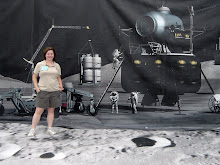A spate of recent articles is covering the presentation of the first orbital uranium maps of the lunar surface, like this article in SpaceRef (the original work was presented by the Kaguya GRS team, including my former colleague Bob Reedy, at this year's LPSC). Some of these articles suggest that the new maps mean "nuclear power plants could be built on the moon, or even that Earth's satellite could serve as a mining source for uranium needed back home." Just how significant is this new finding?
The media is spinning this as "uranium discovered on the Moon," but in fact we've known about uranium in lunar samples since the return of the Apollo 11 samples in 1968. When the lunar samples came back, there was a phase in them that was highly enriched in potassium (K), rare earth elements (REE) and phosphorus (P), among other freaky elements. This material was nicknamed KREEP, and the moniker stuck. Lunar rocks are known to contain hundreds of ppb uranium, and some minerals up to 4000 ppm. The natural decay of uranium to He and lead is a commonly-used dating scheme for lunar rock ages.
So what is this KREEP layer, anyway? During planetary formation, minerals crystallize and sink or float depending on their density. That gives early planets a layered internal structure - the crust, mantle, and core. However, uranium (along with other similar elements like Th, K, etc.) doesn't have an affinity for fitting into most common minerals. They are called "incompatible" elements for being incompatible with mineral structures. As the Moon crystallized, these elements stayed in a liquid layer and wound up being squeezed between the crust and mantle. This layer contains all those incompatible elements, the leftovers of differentiation.
After the Moon formed its layered structure, giant impacts dug below the crust and scattered the KREEP layer over the surface, mostly on the nearside where the crust is thin. So when you look at a thorium map of the Moon, you're looking at the surface expression of KREEP, including all those incompatible elements like U.
The real news story here isn't that there is uranium on the Moon, but that it's the first time U has been directly detected from orbit. The natural decay of uranium emits characteristic gamma rays, which can be measured from orbit by very sensitive instrumentation. Because U is only present in trace amounts, it's a truly amazing accomplishment for the Kaguya GRS to measure these gamma rays from orbit. The new information will allow us to understand the distribution of U on the surface, which gives us insight into how the KREEP layer was dug up and flung about. Congratulations to the Kaguya GRS team!
Subscribe to:
Post Comments (Atom)

1 comment:
Nicely explained!
Susan
Post a Comment